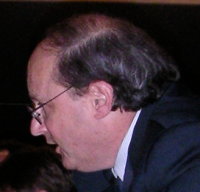- Paul Steinhardt
Infobox Scientist
box_width = 300px
name = Paul J. Steinhardt
image_width = 250px
caption = At the 2008World Science Festival inNew York City
birth_date =
birth_place =
death_date =
death_place =
residence = U.S.
citizenship =
nationality =
ethnicity =
fields =Physics
workplaces =Princeton University University of Pennsylvania Harvard Society of Fellows Harvard University California Institute of Technology
doctoral_advisor =
academic_advisors =
doctoral_students =
notable_students =
known_for =Cosmic inflation ,Cyclic Model ,Ekpyrotic universe ,Quintessence ,Quasicrystals
author_abbrev_bot =
author_abbrev_zoo =
influences =
influenced =
awards =
religion =
footnotes =Paul J. Steinhardt is the
Albert Einstein Professor of Science atPrinceton University and aprofessor oftheoretical physics . He received his B.S. at theCalifornia Institute of Technology and his Ph.D. in Physics atHarvard University . He was a Junior Fellow in theHarvard Society of Fellows and Mary Amanda Wood Professor of Physics at theUniversity of Pennsylvania before joining the faculty atPrinceton University in 1998. He is currently the Director of the Princeton Center for Theoretical Science.He is best known for his work in theoretical cosmology, where he helped develop the theory of
cosmic inflation , which attempts to explain the homogeneity and geometry of the universe and the origin of the fluctuations that seeded the formation of galaxies and large-scale structure. He introduced the concept of quintessence, a time-varying form ofdark energy to explain the current accelerating expansion of the universe. His recent work has been onbrane cosmology , especially the ekpyrotic and cyclic models. The cyclic theory of the universe is a radical alternative to big bang/inflationary cosmology in which the evolution of the universe is periodic and the key events shaping the large scale structure of the universe occur before the big bang.Steinhardt also works in
condensed matter physics , where he introduced the concept ofquasicrystal s, a novel phase of matter which has symmetries forbidden to ordinary periodiccrystal s. He has made numerous contributions to understanding their mathematical and physical properties. Recently, he has helped develop a photonic quasicrystal (the quasicrystal analogue of aphotonic crystal ) for efficiently trapping and manipulating light in selected wavebands.He is a Fellow in the
American Physical Society and a member of theNational Academy of Sciences . In 2002, he received the P.A.M. Dirac Medal from theInternational Centre for Theoretical Physics .ee also
*
Girih tiles Homepage
* [http://wwwphy.princeton.edu/~steinh/ Princeton homepage]
References
*P. J. Steinhardt and N. Turok, "A cyclic model of the universe", "Science" 296, 1436(2002) [http://www.arxiv.org/abs/hep-th/0111098 arXiv:hep-th/0111098] .
*P. J. Steinhardt and N. Turok, "Endless Universe: Beyond the Big Bang", (Doubleday, 2007)
*J. Khoury, B. A. Ovrut, P. J. Steinhardt and N. Turok, "The ekpyrotic universe: Colliding branes and the origin of the hot big bang", "Phys. Rev. D" 64, 123522 (2001) [http://www.arxiv.org/abs/hep-th/0103239 arXiv:hep-th/0103239] .
*D. N. Spergel and P. J. Steinhardt, "Observational evidence for self-interacting cold dark matter", "Phys. Rev. Lett." 84, 3760 (2000) [http://www.arxiv.org/abs/astro-ph/9909386 arXiv:astro-ph/9909386] .
*N. A. Bahcall, J. P. Ostriker and P. J. Steinhardt, "The Cosmic Triangle: Revealing the State of the Universe", "Science" 284, 1481 (1999) [http://www.arxiv.org/abs/astro-ph/9906463 arXiv:astro-ph/9906463] .
*R. R. Caldwell, R. Dave and P. J. Steinhardt, "Cosmological Imprint of an Energy Component with General Equation-of-State", "Phys. Rev. Lett." 80, 1582 (1998) [http://www.arxiv.org/abs/astro-ph/9708069 arXiv:astro-ph/9708069] .
*P. J. Steinhardt and S. Ostlund, "The Physics of Quasicrystals" (World Scientific, Singapore, 1987).
*J. M. Bardeen, P. J. Steinhardt and M. S. Turner, "Spontaneous Creation Of Almost Scale-Free Density Perturbations In An Inflationary Universe," "Phys. Rev. D" 28, 679 (1983).
*A. Albrecht and P. J. Steinhardt, "Cosmology For Grand Unified Theories With Radiatively Induced Symmetry Breaking," "Phys. Rev. Lett." 48, 1220 (1982).
Wikimedia Foundation. 2010.
